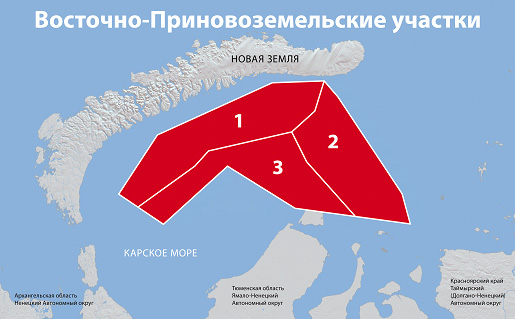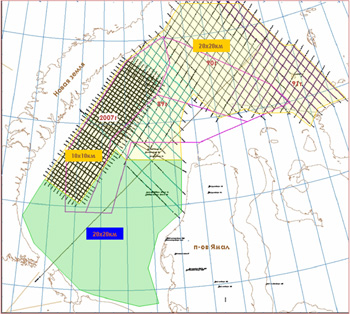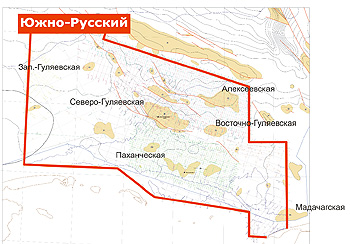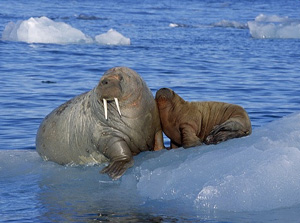Please activate JavaScript in your browser to use all interface options.
Rosneft launched projects in the Kara and Barents Seas in 2010 after obtaining four licenses to explore Russia's Arctic shelf. Three of the licenses relate to blocks in the Kara Sea (East Prinovozemelsky 1, 2 and 3) and the fourth one is for the South-Russky block in the Pechora Sea. The blocks are estimated to hold 21.5 billion tons of oil equivalent.
Kara Sea
The Kara Sea is an extension of the West Siberian oil and gas province, which accounts for 60 percent of Russia's current oil production. The sea is 40-350 meters deep with difficult ice conditions (ice-bound for 270-300 days a year). Winter temperatures plunge to minus 46˚С. Ice ranges in thickness from 1.2 to 1.6 meters. The Prinovozemelsky blocks of the Kara Sea have been explored using 2D seismic. Estimated recoverable oil resources in the three blocks stand at 6.2 billion tons and hydrocarbon resources at up to 20.9 billion tons of oil equivalent.
 |
Estimated recoverable resources at East Prinovozemelsky blocks 1, 2 and 3 in the Kara Sea.
- East Prinovozemelsky block 1
- oil – 3.33 bln tons
- gas – 3.317 bln m3
- East Prinovozemelsky block 2
- oil – 1.82 bln tons
- gas – 2.733 bln m3
- East Prinovozemelsky block 3
- oil – 1.118 bln tons
- gas – 8.54 bln m3
 |
Geological studies of the South Kara basin have identified a number of major prospective structures such as Universitetsky, Vikulovsky, Tatarinov, Rozhdestvensky, Kropotkinsky, Rogozinsky, Rozevsky, East Anabarsky, Matusevich and Vilkitsky.
Further 2D and 3D seismic study of the Prinovozemelsky blocks is planned for 2012-2016. The first wildcat well is scheduled for drilling in 2015.
Cooperation between Rosneft and ExxonMobil in the Kara Sea and the creation of an Arctic Research and Design Center for Offshore Developments (ARC)
In the autumn of 2011 Rosneft and ExxonMobil signed a strategic cooperation agreement for joint development of the three East Prinovozemelsky blocks in the Kara Sea.
As part of the partnership, the two companies will link up to create an Arctic Research and Design Center for Offshore Developments (ARC) in St. Petersburg, which will focus on research and development. It is to become Russia's first competence center capable of solving all the tasks the company will face when developing shelf deposits. It will gather global and Russian expertise, develop key competences needed to develop shelf deposits and create new underwater production technologies, including developing ice-class drilling platforms, ships and rigs and underwater systems for oil preparation and shipment.
Barents Sea
 |
In the South Russky block of the Barents Sea lies the North Gulyaev deposit, which contains 13 million tons of C1+C2 oil and 52 billion cubic meters of gas.
Rosneft experts have conducted comprehensive geological and geophysical surveys on the South Russky block to evaluate hydrocarbon resources and geological risks. They have graded the most promising sites and identified key exploration areas.
The work carried out by company experts has helped develop an understanding of the field's key forecast oil-and-gas-bearing zones and formulate an exploration plan for 2012 in order to gain a deeper understanding and more detailed knowledge of prime sites and prepare them for test drilling in the coming years.
Environment
 |
The basic principle of shelf project implementation is unreserved compliance with the tough requirements of Russia's environmental legislation and international agreements at all stages – from design to the completion of drilling and well abandonment. Rosneft and ExxonMobil experts intend to pay special attention to environmental safety and interaction with the region's indigenous population. Environmental impact assessment will be one of the key functions of the Arctic Research and Design Center for Offshore Developments. It will be used to monitor and evaluate the impact of each shelf project on the environment as well as monitor and prevent emergencies.

-315xx70.png)